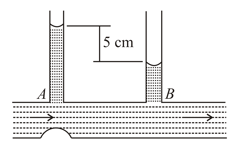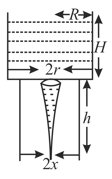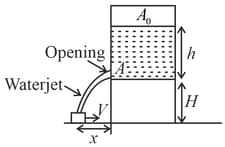EASY
Earn 100
What is difference between rotational and irrotational flow?
Important Questions on Fluid Mechanics
EASY
MEDIUM
What will be the nature of flow of water from a circular tap, when its flow rate increased from to The radius of the tap and viscosity of water are and , respectively. (Density of water : )
EASY
MEDIUM
EASY
HARD
EASY
EASY
HARD
HARD
MEDIUM
EASY
HARD

In the diagram shown, the difference in the two tubes of the manometer is , the cross-section of the tube at and is and respectively. The rate at which water flows through the tube is
MEDIUM
MEDIUM

Consider a water jar of radius R that has water filled up to height H and is kept on a stand of height h (see figure). Through a hole of radius r at its bottom, the water leaks out and the stream of water coming down towards the ground has a shape like a funnel as shown in the figure. If the radius of the cross-section of water stream when it hits the ground is x. Then:
MEDIUM

MEDIUM
(Take )
HARD
Consider the configuration of a stationary water tank of cross-section area and a small bucket as shown in figure below;

What should be the speed of the bucket, so that the water leaking out of a hole of cross-section area (as shown) from the water tank does not fall outside the bucket?
(Take, and ).
MEDIUM
MEDIUM

